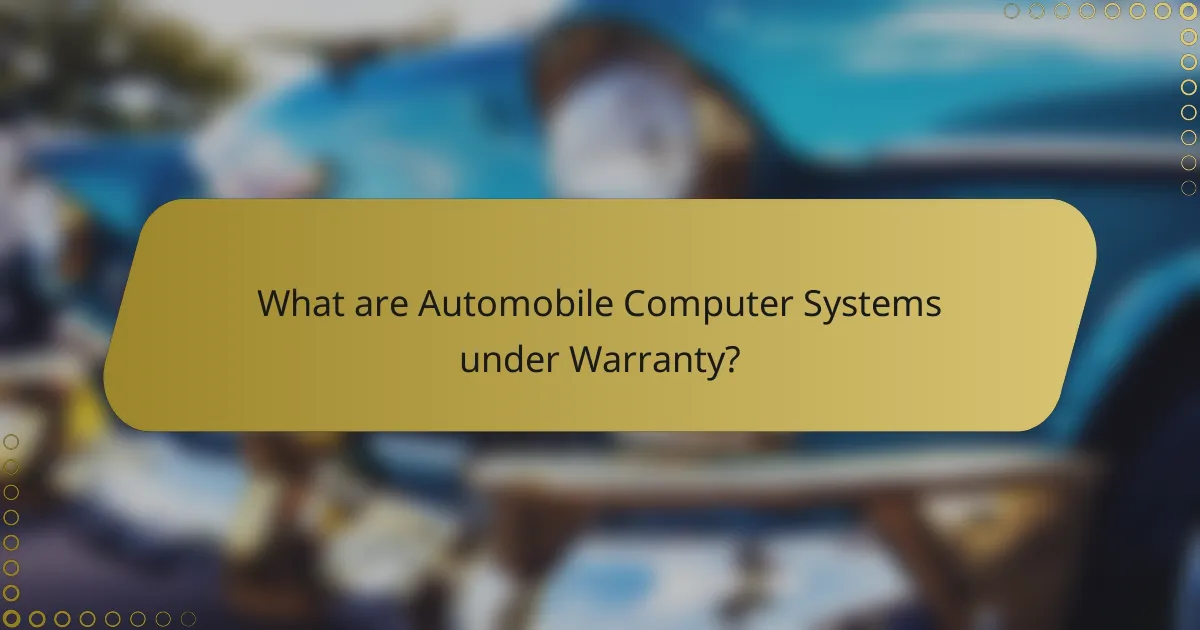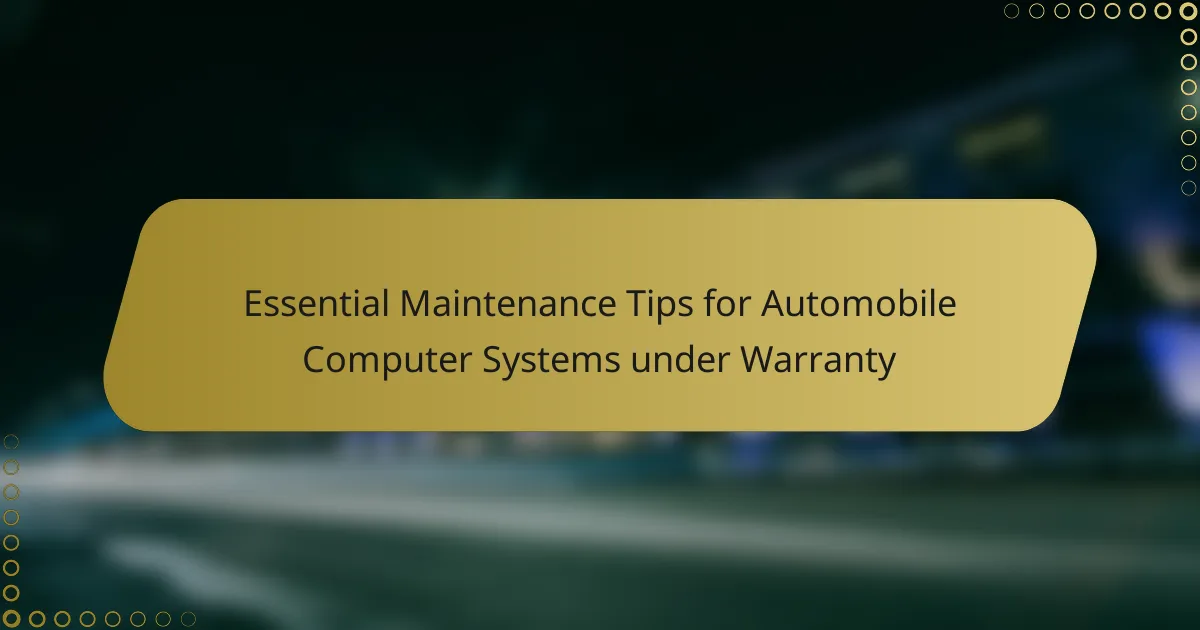Automobile computer systems under warranty are electronic control units, including engine control modules and transmission control units, that manage various vehicle functions. These systems are covered by manufacturer warranties that protect against defects in materials and workmanship for a specified duration or mileage. To ensure optimal performance and maintain warranty compliance, vehicle owners should perform regular software updates, conduct routine diagnostics, and keep hardware components clean. Following manufacturer guidelines, using authorized service centers, and documenting service records are crucial for maximizing warranty benefits and prolonging the life of these critical systems.

What are Automobile Computer Systems under Warranty?
Automobile computer systems under warranty are the electronic control units that manage various functions of a vehicle. These systems include engine control modules, transmission control units, and other onboard computers. They are covered by warranty provided by the manufacturer for a specified period or mileage. The warranty typically covers defects in materials and workmanship. If a system fails within the warranty period, repairs or replacements are often at no cost to the vehicle owner. This coverage ensures that critical components function correctly, enhancing vehicle reliability. Manufacturers may specify conditions for warranty claims, such as regular maintenance. Understanding warranty terms is essential for vehicle owners to maximize coverage benefits.
How do these systems function within a vehicle?
Automobile computer systems function by managing various vehicle operations through electronic control units (ECUs). These ECUs process data from sensors to optimize performance. For example, the engine control unit adjusts fuel injection based on temperature and speed readings. The transmission control unit manages gear shifts for efficient power delivery. Additionally, the body control module oversees lighting, windows, and security systems. Communication between these systems occurs via a network known as the Controller Area Network (CAN). This network allows real-time data exchange, ensuring all systems work harmoniously. Regular software updates and diagnostics are essential for maintaining optimal functionality.
What are the key components of automobile computer systems?
The key components of automobile computer systems include the Engine Control Unit (ECU), Transmission Control Unit (TCU), and Body Control Module (BCM). The ECU manages engine performance and emissions. The TCU oversees transmission functions for optimal shifting. The BCM controls various body functions such as lighting and climate control. Additionally, sensors collect data for these units to process. These components work together to enhance vehicle efficiency and safety. The integration of these systems allows for real-time diagnostics and performance monitoring.
How do these components interact with each other?
Automobile computer systems consist of various components such as sensors, control units, and communication networks. These components interact through data exchange and feedback loops. Sensors collect data from the vehicle’s environment and send it to control units. Control units process this data to make decisions, such as adjusting engine performance. Communication networks facilitate the transfer of information between different components. For instance, the Engine Control Unit (ECU) communicates with the Transmission Control Unit (TCU) to optimize gear shifting. This interaction ensures the vehicle operates efficiently and safely. Regular maintenance helps ensure these components function properly and maintain effective communication.
Why is warranty coverage important for these systems?
Warranty coverage is important for automobile computer systems because it protects against unexpected repair costs. These systems are complex and can fail due to manufacturing defects. A warranty ensures that repairs or replacements are covered without additional expense to the owner. According to a study by the Automotive Research Center, nearly 30% of vehicle electronic failures occur within the warranty period. This highlights the financial security a warranty provides. Additionally, warranty coverage often includes access to specialized technicians who understand the systems better. This can lead to more effective and timely repairs. Overall, warranty coverage is essential for maintaining the functionality and longevity of automobile computer systems.
What does a typical warranty cover for automobile computer systems?
A typical warranty for automobile computer systems covers defects in materials and workmanship. This includes the engine control unit, transmission control module, and other electronic components. The warranty usually lasts for a specific period, often three to five years or a certain mileage, whichever comes first. It may also cover repairs related to software issues and updates. Some warranties provide coverage for labor costs associated with the repair. However, damage due to misuse or external factors is often excluded. It’s essential to review the warranty terms for specific coverage details.
How can warranty terms affect maintenance practices?
Warranty terms significantly influence maintenance practices for automobile computer systems. Specific warranty conditions often dictate the required maintenance schedule. For instance, some warranties necessitate regular servicing at authorized centers. This ensures compliance with warranty stipulations. Failure to adhere to these terms can void the warranty. Moreover, warranties may specify the use of particular parts or fluids. This can impact maintenance choices and costs. Additionally, warranties often outline what constitutes acceptable wear and tear. Understanding these terms helps vehicle owners maintain their systems effectively. Overall, warranty terms serve as a guideline for responsible maintenance practices.

What essential maintenance practices should be followed?
Regular software updates are essential maintenance practices for automobile computer systems under warranty. Keeping software updated ensures optimal performance and security. Manufacturers often release updates to fix bugs and enhance features. Regularly checking for updates can prevent potential issues. Additionally, routine diagnostics should be performed to identify any irregularities. This helps in addressing problems before they escalate. Cleaning the system’s hardware components is also vital. Dust and debris can impact performance and lead to failures. Lastly, maintaining proper battery health is crucial. A weak battery can affect the computer system’s functionality. Following these practices can prolong the life of the automobile’s computer system and uphold warranty conditions.
How can vehicle owners ensure optimal performance of computer systems?
Vehicle owners can ensure optimal performance of computer systems by regularly updating software and firmware. Keeping the vehicle’s software current enhances system functionality and security. Owners should also perform routine diagnostics to identify potential issues early. This can prevent minor problems from escalating into major failures. Additionally, maintaining a clean battery connection is crucial. Corrosion can hinder electrical performance. Using quality fuel and maintaining proper tire pressure can also positively impact overall vehicle performance, indirectly benefiting the computer systems. Regularly checking for error codes can provide insights into system health. Following the manufacturer’s maintenance schedule ensures that all components, including computer systems, are functioning efficiently.
What routine checks should be performed on these systems?
Routine checks on automobile computer systems include verifying software updates. Regular updates ensure optimal performance and security. Inspecting diagnostic trouble codes is also essential. This process identifies potential issues early. Checking connections and wiring for wear is crucial. Damaged components can lead to system failures. Monitoring battery health is important as well. A weak battery can affect system functionality. Lastly, reviewing system logs helps in tracking performance trends. These checks help maintain reliability and prevent costly repairs.
How often should software updates be conducted?
Software updates should be conducted regularly, ideally every month. Regular updates ensure that the automobile’s computer systems function optimally. They help in fixing bugs and improving performance. Additionally, updates often include security patches to protect against vulnerabilities. The National Highway Traffic Safety Administration recommends checking for updates at least monthly. This practice helps maintain the warranty and enhances vehicle safety. Regular updates can prevent potential issues that could arise from outdated software.
What are the common signs of issues in automobile computer systems?
Common signs of issues in automobile computer systems include warning lights on the dashboard. These lights indicate specific malfunctions detected by the system. Unresponsive controls or features can also signal computer issues. Erratic behavior in electronic components, such as inconsistent engine performance, may occur. Additionally, frequent system resets or malfunctions can indicate underlying problems. Diagnostic trouble codes (DTCs) may be stored in the system, providing specific error information. Poor fuel efficiency can also suggest computer-related issues affecting engine management. Lastly, unusual sounds or vibrations during operation may point to electronic system failures.
How can drivers identify potential problems early?
Drivers can identify potential problems early by conducting regular vehicle inspections. They should check fluid levels, tire pressure, and brake functionality consistently. Listening for unusual noises while driving is also crucial. Monitoring dashboard warning lights can provide immediate alerts to issues. Additionally, drivers should pay attention to changes in vehicle performance, such as reduced acceleration or strange vibrations. Keeping a maintenance log helps track any recurring problems. Research indicates that early detection can prevent more severe damage and costly repairs. Regular check-ups at authorized service centers can enhance problem identification.
What specific warning indicators should be monitored?
Specific warning indicators to monitor in automobile computer systems include engine warning lights, battery voltage levels, and coolant temperature readings. These indicators help identify potential issues early. Monitoring diagnostic trouble codes (DTCs) is also essential for understanding system malfunctions. Additionally, observing fuel efficiency trends can signal underlying problems. Regularly checking tire pressure monitoring system (TPMS) alerts is crucial for safety. Keeping an eye on transmission fluid levels can prevent costly repairs. Lastly, monitoring brake system alerts ensures optimal vehicle performance.

What are the best practices for maintaining warranty compliance?
To maintain warranty compliance, follow manufacturer guidelines strictly. Regular maintenance is essential for keeping warranty valid. Use authorized service centers for repairs and inspections. Document all service records meticulously for accountability. Avoid unauthorized modifications to the vehicle’s computer system. Adhere to recommended service intervals specified in the owner’s manual. Use only manufacturer-approved parts during repairs. Compliance with these practices ensures protection under warranty agreements.
How can vehicle owners avoid voiding their warranties?
Vehicle owners can avoid voiding their warranties by adhering strictly to the manufacturer’s maintenance schedule. This schedule typically includes regular oil changes, tire rotations, and inspections. Additionally, using OEM (Original Equipment Manufacturer) parts for repairs is crucial. Many warranties specify that aftermarket parts can void coverage. Documenting all maintenance and repairs is essential for warranty claims. Keeping receipts and service records provides proof of compliance. Understanding the warranty terms is vital; vehicle owners should read their warranty documents carefully. Lastly, avoid unauthorized modifications, as they can lead to warranty disputes. Following these guidelines helps ensure warranty protection remains intact.
What maintenance tasks should be documented for warranty purposes?
Maintenance tasks that should be documented for warranty purposes include regular oil changes, tire rotations, and brake inspections. Documenting these tasks ensures compliance with manufacturer requirements. Additionally, recording software updates and diagnostic checks is essential. Each of these tasks contributes to the overall performance and reliability of the automobile. Keeping accurate records provides proof of maintenance history. This documentation can be crucial when filing warranty claims. It demonstrates that the owner has adhered to recommended maintenance schedules. Ultimately, thorough documentation protects the owner’s investment in the vehicle.
How can regular service intervals impact warranty validity?
Regular service intervals can significantly impact warranty validity. Manufacturers often require scheduled maintenance to keep warranties intact. Failure to adhere to these intervals may result in warranty claims being denied. For example, if an engine issue arises and the vehicle has not been serviced as recommended, the manufacturer may refuse coverage. Documentation of completed services is crucial for warranty claims. Each service record acts as proof of compliance with warranty terms. Therefore, maintaining regular service intervals is essential for protecting warranty rights.
What troubleshooting steps can be taken if issues arise?
Check the vehicle’s user manual for specific troubleshooting guidelines. Restart the automobile’s computer system to reset any temporary glitches. Inspect all connections and wiring for damage or loose fittings. Verify that all software updates are installed on the vehicle’s computer system. Run diagnostic tests using an OBD-II scanner to identify error codes. Address any error codes by following manufacturer-recommended solutions. If issues persist, consult a certified technician for professional assistance. Document all troubleshooting steps taken for warranty purposes.
How should one approach diagnostic tests for computer systems?
One should approach diagnostic tests for computer systems methodically. Begin by identifying the specific symptoms or issues present in the system. Gather relevant data, such as error codes or performance metrics. Utilize diagnostic tools and software designed for the specific system being tested. Conduct tests systematically, starting with the most likely causes based on gathered data. Document all findings and changes made during the testing process. Analyze results to determine if further action is required. Regular diagnostic testing can prevent future issues and maintain system performance.
What practical tips can help maintain automobile computer systems?
Regularly update software to ensure optimal performance. This can prevent glitches and improve system functionality. Check for updates from the manufacturer or authorized service centers.
Keep connections clean and secure. Dirt or corrosion can disrupt communication between components. Regularly inspect and clean connectors and wiring harnesses.
Monitor battery health. A weak battery can cause voltage fluctuations, affecting computer systems. Replace batteries as needed to maintain consistent power supply.
Use diagnostic tools for early detection. Tools can identify issues before they escalate. Regular diagnostics can help pinpoint problems related to the computer systems.
Follow manufacturer maintenance schedules. Adhering to recommended service intervals ensures all systems are functioning properly. This includes inspections and software updates.
Educate yourself on error codes. Understanding these codes can help in troubleshooting issues. Refer to the vehicle’s manual for specific meanings and recommended actions.
Automobile computer systems under warranty are critical electronic control units that manage various vehicle functions, such as engine performance and transmission operations. This article outlines essential maintenance tips to ensure these systems remain functional and compliant with warranty terms, including the importance of regular software updates, routine diagnostics, and proper documentation of maintenance tasks. It also highlights the significance of understanding warranty coverage and adhering to manufacturer guidelines to avoid voiding the warranty. By following these practices, vehicle owners can enhance the reliability and longevity of their automobile’s computer systems.
